Organisms and Populations - Revision Notes
CBSE Class 12 Biology
Revision Notes
CHAPTER-13
ORGANISMS AND POPULATIONS
Ecology is the branch of biology that deals with the interactions among organisms and between the organism and its physical (abiotic) environment . Study of ecology is important to strike a balance between development and maintenance of natural environmental and biotic communities, use and conservation of resources, solve local , regional and global environmental problems.
- It is basically concerned with four levels of biological organisation – organisms, populations, communities and biomes.
- Ecological hierarchy or ecological level of organization connected with ecological grouping of organisms.
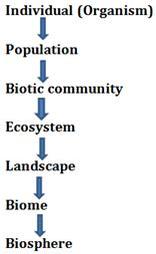
- Organism and its Environment
- The sum total of all biotic and abiotic factors, substances and conditions that surround and potentially influence organisms without becoming their constituent part is called environment.
At organism level, physiological ecology tries to understand how different organisms are adapted to their environment in terms of survival and reproduction. The variation in the intensity and duration of temperature along with annual variations in precipitation results in formation of major biomes like desert, rain forest and tundra.
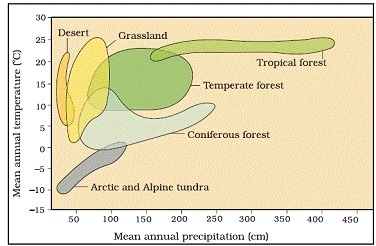
- Regional and local variations within each biome lead to the formation of different kinds of habitats like tropical rain forest, deciduous forest, desert, sea coast etc.
- The habitat includes biotic components like pathogens, parasites, predators and competitors of the organism with which they interact constantly.
Major Abiotic Factors
a) Temperature- is the most important ecological factor to determine the bio-mass of a place. Average temperature on land varies seasonally and decreases progressively from the equator towards the poles and from plains to mountain tops. Temperature affects the kinetics of enzymes and basal metabolism along with physiological functions of the organisms.
- The organisms that can tolerate wide range of temperature are called eurythermal ,for example cat , dogs , tigers etc.
- The organism which have the ability to tolerate only a narrow range of temperature are called stenothermal ,for example Penguin, fishes,crocodile.etc.
b) Water- life on earth is unsustainable without water. Productivity and distribution of plants is heavily dependent on water. For aquatic organisms the quality (chemical composition, pH) of water becomes important. The salt concentration (measured as salinity in parts per thousand), is less than 5 in inland waters, 30-35 in the sea and > 100 in some hypersaline lagoons
- The organisms that can tolerate wide range of salinities are called euryhaline ,for example salmon , hierring etc.
- The organism which have the ability to tolerate only a narrow range of salinities are called stenohaline, for example goldfish ( freshwater ) and haddock ( marine water )etc.
c) Light- plants produce food through photosynthesis in presence of sunlight. Some plants are adapted to low light conditions because they are overshadowed by tall canopied trees. Flowering in some plants occurs only in presence of critical day light called Photoperiodism. The availability of light and land is closely linked that of temperature as the sun is the source of both. UV component of sunlight is harmful to plants and animals.
d) Soil- Types of soil depends upon climate, weathering process, whether soil is transported or sedimentary and how soil development occurred. Soil composition, grain size and aggregation determine the percolation and water holding capacity of the soils along with pH, mineral, composition and topography determine the vegetation in any area.
Responses to Abiotic Factor : In the course of evolution, many species have evolved constant internal environment to permits all biochemical reactions and physiological functions to work with maximum efficiency to have over all fitness of species. Organisms try to maintain the constancy of its internal environment (homeostasis)inspite of varying external environment. There are various ways to establish hemostasis-
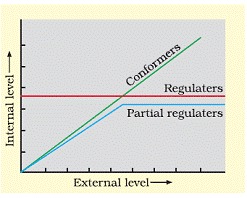
- Regulate- all birds and animals are capable of maintaining homeostasis by physiological means which ensures constant body temperature, constant osmotic concentration etc. Thermoregulation and osmoregulation is the source of success of mammals in all the environmental conditions. In summer, when outside temperature is more than our body temperature, we sweat oftenly, resulting evaporative cooling, which brings down the body temperature. In winter we start to shiver, a kind of exercise which produces heat and raises the body temperature.
- Conform- most of animals and plants, their body temperature change with ambient temperature. In aquatic animals osmotic concentration of the body fluid change with that of the ambient water osmotic concentration. These animals are called conformer. Conformer are not able to bear the energetic expenses to maintain the constant body temperature.
Heat loss or heat gain is a function of surface area. Since small animals have a larger surface area relative to their volume, they tend to lose body heat very fast when it is cold outside; then they have to expend much energy to generate body heat through metabolism. This is the main reason why very small animals are rarely found in polar regions. - Migrate- the organism move away for time being from the stressful unfavorable habitat to more suitable habitat and return back when stressful period is over. Many birds undertake long-distance to migrate to more hospitable areas. Siberia birds migrate to Keolado National park, Bharatpur, India.
- Suspend- in microorganisms like bacteria, fungi and lower plants a thick walled spores is formed which help them to survive unfavorable conditions. These spores germinate on return of suitable conditions. In higher plants, seeds and some other vegetative reproductive structures serves the means to tide over periods of stress and help them in dispersal also. The metabolic activities are reduced to minimum during this dormant period.
a)Hibernation - the condition or period of an animal or plant spending the winter in a dormant state e.g bear
b)Aestivation - the condition or period of an animal or plant spending the summer to avoid heat and dessication in a dormant state e.g snails .
c)Diapause - a stage of suspended development in zooplankton species in lakes and ponds.
Adaptation is the attribute of organism morphological, physiological and behavioral changes that enables the organism to survive and reproduce in its habitat.
- Kangaroo rat in North American deserts fulfill the water requirement by internal oxidation of fat in absence of water.It also has the ability to concentrate its urine so that minimal volume of water is used to remove excretory products.
- Thick cuticle in many plants also prevents loss of water. CAM plants open their stomata during night to reduce the loss of water during photosynthesis.
- Mammals from colder climates have shorter ears and limbs to minimize heat loss. This is called Allen’s Rule.
- In polar seas aquatic mammals like seals have a thick layer of fat called blubber, below their skin that acts as an insulator and reduces loss of body heat.
- Altitude sickness is observed at higher altitude that includes symptoms like nausea, fatigue, heart palpitations due to less oxygen and atmospheric pressure. The person gradually get acclimatized and stop experiencing altitude sickness. This is type of physiological adaptation.
- A number of marine invertebrate and fish live in temperature always less than zero and some lives in greatdepth in ocean where pressure is very high by array of biochemical adaptations.
- Some organisms like desert lizard lack the physiological ability that mammals have but deal with high temperature of their habitat by behavioral means. They bask in the sun and absorb heat and when their body temperature drops below the comfort zone, but moves in shade when the ambient temperature starts increasing.
Populations : Individuals of any species live in groups in well-defined geographical area, share or compete for similar resources, potentially interbreed and constitute a population.
Population Attributes : A population has certain attributes that an individual organism does not such as an individual may have births and deaths, but a population has birth rates and death rates.
- The birth and death rates are referred as per capita births or deaths respectively, which is increase and decrease with respect to members of the population.
- Sex ratio is another attributes of population. An individual may be male or female but population has sex ratio.
- A population at given time composed of different individual of different ages. If the age distribution is plotted for the population, the resulting structure is called age pyramids. The shape of pyramids reflects the shape of growth status of population. Which may be
(i) Expending
(ii) Stable
(iii) Declining

§ Population size or population density (N) is measured in terms of number but it may sometime not appropriate.
Population Growth : The size of population is not static. It keeps changing with time, depending upon food availability, predation pressure and reduces weather. The main factors that determine the population growth are-
o Natality (number of birth during a given period in the population)
o Mortality ( number of death during a given period in the population)
o Immigration (individual of same species that have come into the habitat)
o Emigration ( individual of population that have left the habitat )

If ‘N’ is the population density at a time‘t’, then its density at time t+1 is
Nt + 1 Nt + [(B + I) – (D + E)]
Population density will increase if the number of births plus the number of immigrants (B + I) is more than the number of deaths plus the number of emigrants (D + E), otherwise it will decrease.
Growth model
Growth of population takes place according to availability of food, habit condition and presence of other biotic and abiotic factors. There are two main types of models-
i. Exponential Growth- in this kinds of growth occurs when food and space is available in sufficient amount. When resources in the habitat are unlimited, each species has the ability to realise fully its innate potential to grow in number .The population grows in an exponential or geometric fashion. If in a population of size N, the birth rates as represented as ‘b’ and death rate as ‘d’. Then increase and decrease in N during unit period time ‘t’ will be
dN / dt = (b – d) × N
Let (b – d) = r, then
dN / dt = rN
Then, the r in this equation is called ‘intrinsic rate of natural increase’.
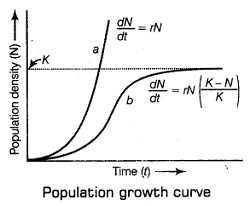
ii. Logistic Growth- there is a competition between the individuals of a population for food and space. The fittest organism survives and reproduces. In this types of growth initially shows a leg phase followed by phases of acceleration and de-acceleration.
Where N = Population density at time t
R = Intrinsic rate of natural increase
K = Carrying capacity
Since resources for growth for populations are finite and become limiting , the logistic growth model is considered a more realistic one.
Population interaction
All animals, plants and microbes in a biological community interact with each other. These interactions may be beneficial, detrimental or neutral to one of species or both. Following types of interaction is seen-
a. Predation
b. Competition
c. Parasitism
d. Commensalism
e. Mutualism
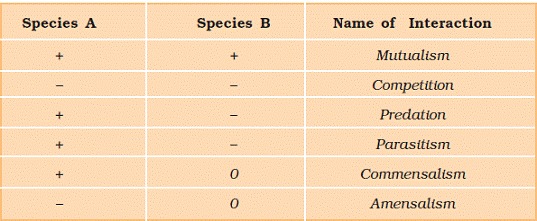
PREDATION : It is an Interspecific Interaction where one animal kills and consumes the other weaker animal.
Roles of Predators
- Transfer energy from plants to higher trophic levels (position of organism in food chain)
- Control Prey population – Prickly pear cactus- moth
- Biological control of Agricultural pest
- Maintain species diversity by reducing intensity of competition among competing prey species
- Over exploitation of prey by the predators results in extinction of prey and predator.
- Defense to lessen impact of predation
a)Insects and frog – camouflage
b)Monarch butterfly – poisonous
PLANTS MORPHOLOGICAL AND CHEMICAL DEFENCES
- Thorns- cactus and Acacia
- Produce and store chemical – Calotropis
- Nicotine, Caffeine, Quinin, Strychnine, opium – against grazers & browsers
COMPETITION
Interaction either among individuals of same species or between individuals of different species.
Occurs among closely related species but not always true
1. Unrelated species also compete- flamingo & fish compete for zooplankton
2. Feeding efficiency of a species reduce due to other species even if resources are plenty – Abingdon tortoise.
Evidence for competition
Competitive release – species distribution restricted to small areas due to competitively superior species.
GAUSE’S COMPETITION EXCLUSION PRINCIPLE
“Two closely related species competing for same resources cannot coexist as the competitively inferior one will be eliminated.”
Resource partition- Two competing species avoid competition by diff. feeding and foraging patterns-Mc Arthur (warblers foraging activities)
PARASITISM
It is the interaction where one species (parasite) depends on the other species (host) for food and shelter, host is harmed.
- Parasites and host self-evolve.
- Adaptations of parasites
- Loss of unnecessary sense organs
- Hooks and sucker
- Loss of digestive system
- High Reproductive capacity
- Parasites-
(i) Reduce the survival of host
(ii) Growth and reproductive rate are reduced
(iii) Render the host vulnerable to its predators by making them weak
Types of parasite
ECTOPARASITES-depend on external surface of host
Example - head lice on humans, ticks on dogs
ENDOPARASITES-take shelter within the body of the host organism
Example - Liverfluke, Plasmodium
MUTUALISM
It is interaction in which both the interacting species are benefited
Examples
1. Lichen – fungi and algae
2. Mycorrhizae - fungi and roots of higher plants
3. Pollination of plants by insects
4. Mediterranean orchid- sexual deceit for pollination- appears as female bee
AMENSALISM: Interaction between two different species, in which one species is harmed and the other species is neither harmed nor benefited. Example. Bacterial culture, after few days fungus growth will be there on it like Pencillium, and its secretions of chemical will kill bacteria, but no benefits to fungi.